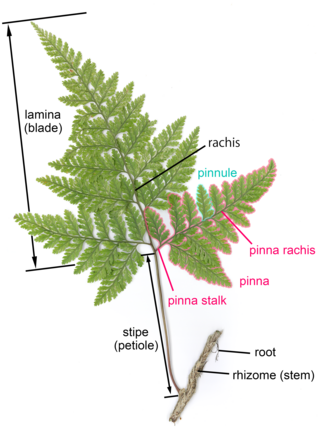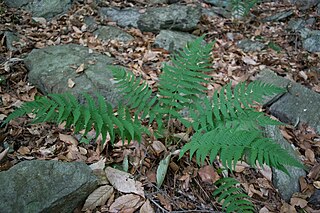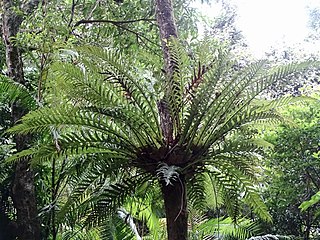
The ferns are a group of vascular plants that reproduce via spores and have neither seeds nor flowers. They differ from mosses by being vascular, i.e., having specialized tissues that conduct water and nutrients and in having life cycles in which the branched sporophyte is the dominant phase.

Lycopodiopsida is a class of vascular plants known as lycopods, lycophytes or other terms including the component lyco-. Members of the class are also called clubmosses, firmosses, spikemosses and quillworts. They have dichotomously branching stems bearing simple leaves called microphylls and reproduce by means of spores borne in sporangia on the sides of the stems at the bases of the leaves. Although living species are small, during the Carboniferous, extinct tree-like forms (Lepidodendrales) formed huge forests that dominated the landscape and contributed to coal deposits.

The lycophytes, when broadly circumscribed, are a group of vascular plants that include the clubmosses. They are sometimes placed in a division Lycopodiophyta or Lycophyta or in a subdivision Lycopodiophytina. They are one of the oldest lineages of extant (living) vascular plants; the group contains extinct plants that have been dated from the Silurian. Lycophytes were some of the dominating plant species of the Carboniferous period, and included the tree-like Lepidodendrales, some of which grew over 40 metres (130 ft) in height, although extant lycophytes are relatively small plants.

The Embryophyta, or land plants, are the most familiar group of green plants that comprise vegetation on Earth. Embryophytes have a common ancestor with green algae, having emerged within the Phragmoplastophyta clade of green algae as sister of the Zygnematophyceae. The Embryophyta consist of the bryophytes plus the polysporangiophytes. Living embryophytes therefore include hornworts, liverworts, mosses, lycophytes, ferns, gymnosperms and flowering plants. The land plants have diplobiontic life cycles and it is accepted now that they emerged from freshwater, multi-celled algae.

A frond is a large, divided leaf. In both common usage and botanical nomenclature, the leaves of ferns are referred to as fronds and some botanists restrict the term to this group. Other botanists allow the term frond to also apply to the large leaves of cycads, as well as palms (Arecaceae) and various other flowering plants, such as mimosa or sumac. "Frond" is commonly used to identify a large, compound leaf, but if the term is used botanically to refer to the leaves of ferns and algae it may be applied to smaller and undivided leaves.

The order Cyatheales, which includes most tree ferns, is a taxonomic order of the fern class, Polypodiopsida. No clear morphological features characterize all of the Cyatheales, but DNA sequence data indicate the order is monophyletic. Some species in the Cyatheales have tree-like growth forms from a vertical rhizome, others have shorter or horizontal expanding rhizomes.

A houseplant, sometimes known as a pot plant, potted plant, or an indoor plant, is an ornamental plant that is grown indoors. As such, they are found in places like residences and offices, mainly for decorative purposes. Common houseplants are usually tropical or semi-tropical, and are often epiphytes, succulents or cacti.

Equisetidae is one of the four subclasses of Polypodiopsida (ferns), a group of vascular plants with a fossil record going back to the Devonian. They are commonly known as horsetails. They typically grow in wet areas, with whorls of needle-like branches radiating at regular intervals from a single vertical stem.

Polystichum munitum, the western swordfern, is an evergreen perennial fern native to western North America, where it is one of the most abundant ferns in forested areas. It occurs along the Pacific coast from southeastern Alaska to southern California, and also inland east to southeastern British Columbia, northern Idaho and western Montana, with disjunctive populations in northern British Columbia, Canada; the Black Hills in South Dakota, United States; and Guadalupe Island off of Baja California, Mexico. Western swordfern is known to have locally naturalized in parts of Great Britain and Ireland.

Pteridium aquilinum, commonly called bracken, brake, common bracken, and also known as eagle fern, is a species of fern occurring in temperate and subtropical regions in both hemispheres. Originally native to Eurasia and North America, the extreme lightness of its spores has led to it achieving a cosmopolitan distribution.

Gymnocarpium dryopteris, the western oakfern, common oak fern, oak fern, or northern oak fern, is a deciduous fern of the family Cystopteridaceae. It is widespread across much of North America and Eurasia. It has been found in Canada, the United States, Greenland, China, Japan, Korea, Russia, and most of Europe. It is a seedless, vascular plant that reproduces via spores and have a life cycle with alternating, free-living sporophyte and gametophyte phases.

Dryopteris marginalis, vernacularly known as the marginal shield fern or marginal wood fern, is a perennial species of fern found in damp shady areas throughout eastern North America, from Texas to Minnesota and Newfoundland. It favors moderately acid to circumneutral soils in cooler areas but is fairly drought-resistant once established. In the warmer parts of its range, it is most likely to be found on north-facing non-calcareous rock faces. It is common in many altitudes throughout its range, from high ledges to rocky slopes and stream banks. Marginal wood fern's name derives from the fact that the sori are located on the margins, or edges of the leaflets.

Ceratopteris thalictroides is a fern species belonging to the genus Ceratopteris, one of only two genera of the subfamily Parkerioideae of the family Pteridaceae.

Aglaomorpha fortunei, commonly known as gu-sui-bu, is a species of basket fern of the family Polypodiaceae. The plant is native to Eastern Asia, including eastern China.

Aglaomorpha is a genus of ferns in the subfamily Drynarioideae of the family Polypodiaceae. The Pteridophyte Phylogeny Group classification of 2016 uses this genus name, while other sources use Drynaria to include Aglaomorpha. Species are commonly known as basket ferns. As circumscribed in PPG I, the genus contains around 50 species.

Drynarioideae is a subfamily of the fern family Polypodiaceae in the Pteridophyte Phylogeny Group classification of 2016 (PPG I). The subfamily is also treated as the tribe Drynarieae within a very broadly defined family Polypodiaceae sensu lato. In either case, it includes the previously separated tribe Selligueeae.

Aglaomorpha quercifolia, commonly known as the oakleaf fern or oakleaf basket fern, is a species of Aglaomorpha in the family Polypodiaceae. Other common names for the fern are pakpak lawin, gurar, koi hin, ashvakatri, kabkab, kabkaban, or uphatkarul.

Aglaomorpha rigidula is a species of tropical fern in genus Aglaomorpha widely distributed throughout Southeast Asia, from Southwest China to Queensland and New South Wales in Australia. Growing as an epiphyte or lithophyte, its green fronds are up to 1.22 metres in length. This fern develops two types of fronds, some of which near the base of the plant are shorter, sterile, and rust-colored which form a basket-like shape that trap moisture and organic components that nourish it. Especially in colder weather, this basket acts as prime habitat for animals such as the Amethystine python.

Aglaomorpha bonii is a species of subtropical fern native to Southeast Asia. Growing as an epiphyte or lithophyte, its rhizome is covered in dry, paper-like fronds while the larger fronds are fertile and bear spores. This fern has long been used in traditional medicine in Vietnam to treat a variety of ailments, and in scientific research, compounds from the plant have demonstrated antibacterial and antioxidant properties.

Aglaomorpha willdenowii is a species of subtropical fern native to the islands of Comoros, Madagascar, and Mauritius. Drynarioid ferns are largely native to Asia and Oceania, but A. willdenowii is the only species of fern in the genus native to Madagascar. Like other Aglaomorpha, its caudex is covered in dry, scale-like sterile fronds and fine hairs, while the larger green fronds are the fertile ones bearing spores.




















